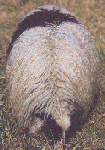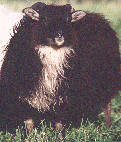 |
Quick Facts About Icelandic
Sheep |
 |
Quick Facts About Icelandic
Sheep |
FLEECE AND FIBER QUALITY | ||
| Dual coated fleece - this fleece is the most versatile of all breeds and is a hand spinner's dream! The wool also felts easily and is prized by fiber artists. The two coats are: | ||
 Black and White Ewe Lamb |
Tog: the soft strong long (to 18 inches) lustrous
outer coat that provides wind, rain, and dust protection for the sheep.
It has little crimp and hangs in loose curls. Used traditionally
for sails, rope, sewing thread, belts, rugs, wall hangings, saddle clothes,
lace shawls, and embroidery yarns. Thel: the soft under coat that keeps the sheep warm. Very fine, as small as 10 microns in diameter. Used for soft fine woolen yarns in under garments, fancy mittens, socks and baby clothes. This fiber has some crimp. | |
| The two coats spun together - make yarns that are similar to a mohair wool blend and are suitable for sweaters, socks, and hats. | ||
| Dual coat easily separated - by hand by just pulling both ends of the lock, or by using wool cards or viking combs. | ||
| Soft "handle" - wool is rated at a 62 to 64 spinning count, fiber ranges from 10 to 27 microns in diameter and feels very soft to the hand. | ||
| Long staple - fleece can grow to 18 inches in a year. For best and cleanest hand spinning fleeces, ewes are sheared twice a year, in March and in November, with the fall clip used for spinning and the spring clip used for felting. | ||
| Minimal preparation - the naturally clean locks only need to have the tips flicked or combed to untangle the long tog and then can be easily spun from the grease or washed locks. It can be processed into carded batts or roving. Viking combs are a natural for this kind of fleece. |  Colorful Icelandic Flock | |
Wide range of natural lustrous fleece colors - 27
different colors and patterns including:
Blacks - can range in hues from blue black, inky black, silvery black and brown black Browns - (called moorit in Iceland) range is from a pale beige, orange-apricot, taffy, milk chocolate, chestnut, dark chocolate, black brown, mocha and silvering browns. Badger Faces - wide range of fleece colors, from buff and champagne through oatmeal. In addition, some parts of the fleece may have gray or silver bases to the fiber Grays - from blue gray, lilac, medium silver, dark gray, and brown grays Mixed Colors - fleeces can have an undercoat that is a different color than the outer coat which produces a true tweed yarn. | ||
| Less lanolin in the fleece - means more fiber yield per pound of raw fleece. Icelandic fleeces have a 20 to 29% shrink, compared to modern breeds where 50% of the fleece weight is in the wool grease. Therefore, a 7 pound Icelandic fleece would yield as much fiber as a 10 lb. fleece of a modern breed. | ||
 Mouflan patterned ewe lamb |
Fleece weights: 5 to 7 pounds per year for adults; 3 to 4 pounds for a 7 month old lamb fleece. | |
| The best fleece for felting - long famous with fiber artists for its excellent felting properties! Makes a fast felting, soft, strong product. Easily made into hats, vests, masks, purses, slippers and boots. Traditionally the yarn was knitted into garments three sizes too large and then felted down to size to make the clothing windproof. | ||
| Commercial yarn popularity - Reynolds Lopi has been
Americas most popular knitting yarn for years and is made with 100% Icelandic
wool. | ||
|
Home | Breeding Stock | Products | Contact Us |
|
|
All
photos, graphics, and text: © Copyright Tongue River Farm, 2002 |